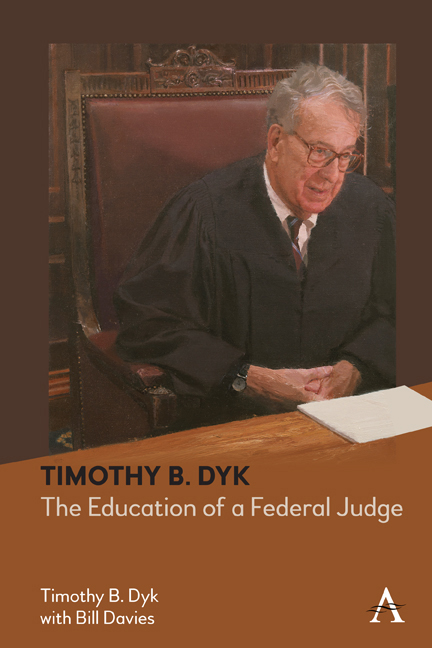Book contents
- Frontmatter
- Dedtication
- Contents
- Foreword
- Acknowledgments
- 1 Introduction
- 2 Family History
- 3 Early Life and Schooling, 1937–61
- 4 Clerking at the Supreme Court, 1961–63
- 5 The Tax Division, 1963–64
- 6 Wilmer Cutler, 1964–90
- 7 Jones Day, 1990–2000
- 8 Reflections on Changes in the Legal Profession
- 9 Becoming a Federal Judge, 1993–2000
- 10 The Confirmation Process, 1998–2000: Selected Diary Entries
- 11 Life as a Federal Judge, 2000–the Present
- 12 Epilogue
- Appendix
- Index
12 - Epilogue
Published online by Cambridge University Press: 15 September 2022
- Frontmatter
- Dedtication
- Contents
- Foreword
- Acknowledgments
- 1 Introduction
- 2 Family History
- 3 Early Life and Schooling, 1937–61
- 4 Clerking at the Supreme Court, 1961–63
- 5 The Tax Division, 1963–64
- 6 Wilmer Cutler, 1964–90
- 7 Jones Day, 1990–2000
- 8 Reflections on Changes in the Legal Profession
- 9 Becoming a Federal Judge, 1993–2000
- 10 The Confirmation Process, 1998–2000: Selected Diary Entries
- 11 Life as a Federal Judge, 2000–the Present
- 12 Epilogue
- Appendix
- Index
Summary
On the eve of a class reunion, Judge Silberman, one of my classmates at Harvard Law School, had his clerks research the various Harvard classes and discovered that our class of 1961 had the largest number of federal appellate judges of any class that had graduated from the Harvard Law School. With Justice Kennedy's retirement from the Supreme Court in 2018, all five of my classmates who became appellate judges have taken senior status or have died (Williams in 2020). Almost all my classmates who joined private firms have also retired, though some have found meaningful work to do after retiring from their firms.
In all courts of appeals, at some point in the judge's tenure on the court there is a portrait painted of the judge which is presented to the court for hanging in one of its courtrooms. Unlike the D.C. Circuit, for example, in our court, the portrait presentation ceremony occurs before the judge leaves the court or takes senior status. In my case, that portrait presentation took place in October 2015 and resulted in a ceremony at which some of my former law clerks spoke. The transcript of the ceremony appears in 878 F.3d. The artist was British, named Brendan Kelly. He has painted portraits of members of the British government and has done the official portrait for Justice Breyer. His portrait of me appears on the cover of this book.
There was an amusing episode about my portrait. My wife and I went to London. Brendan had just finished the portrait. We went to his studio in London to look at it. Brendan had said that if there was something about the portrait that I wanted to have changed, he would address it. When we arrived, Brendan said that he wanted to give us the opportunity to look at the portrait in private, so he would walk around the block and come back. Before leaving, he unveiled the portrait. Both my wife and I were delighted with it—a uniform reaction by those who saw it later. As we talked about it, my wife noticed that one of my hands seemed to be lighter than the rest of the portrait. And so, when Brendan came back, she suggested that he could darken that part of the hand.
- Type
- Chapter
- Information
- Timothy B. DykThe Education of a Federal Judge, pp. 217 - 218Publisher: Anthem PressPrint publication year: 2022

